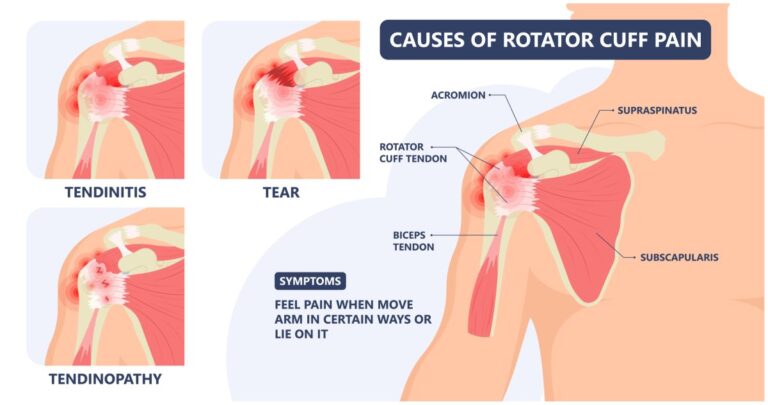
Managing Rotator Cuff Pain: Best Practices and NICE Guidelines
Rotator cuff pain can significantly impact daily activities and quality of life. At Physiopoint, we are dedicated to providing effective, evidence-based treatments in line with UK best practices and NICE (National Institute for Health and Care Excellence) guidelines. This blog post aims to offer guidance on managing rotator cuff pain, highlighting recommended approaches to help you achieve the best possible outcomes.
Understanding Rotator Cuff Pain
The rotator cuff consists of four muscles and their tendons, which provide stability and movement to the shoulder. Injuries to the rotator cuff can result from acute trauma, repetitive strain, or degenerative changes. Symptoms typically include shoulder pain, weakness, and a reduced range of motion.
Best Practices for Managing Rotator Cuff Pain
Comprehensive Assessment and Diagnosis
- A thorough clinical assessment is the first step. This includes a detailed medical history and physical examination to identify the nature and extent of the injury.
- Imaging studies, such as ultrasound or MRI, may be required to confirm the diagnosis and assess the severity of the injury.
Patient Education and Self-Management
- Educating patients about their condition and the importance of adhering to the treatment plan is crucial.
- NICE guidelines recommend providing information on activity modification and techniques to avoid aggravating the injury. Simple changes, such as adjusting your posture or avoiding overhead activities, can significantly reduce pain and prevent further injury.
Physical Therapy and Exercise
- Physiotherapy is a cornerstone of managing rotator cuff pain. A tailored exercise program focusing on strengthening and stretching the shoulder muscles can help restore function and alleviate pain.
- Techniques such as manual therapy, therapeutic ultrasound, and electrotherapy may be used to enhance recovery. Your physiotherapist will guide you through exercises to improve shoulder strength, flexibility, and stability.
Pain Management
- Initial pain relief can be achieved with over-the-counter medications such as paracetamol or non-steroidal anti-inflammatory drugs (NSAIDs).
- In some cases, corticosteroid injections may be considered to reduce inflammation and alleviate pain. These should only be administered following a thorough assessment by a healthcare professional.
Activity Modification
- Advising patients to modify their activities to avoid exacerbating the injury is essential. This may include avoiding heavy lifting or repetitive overhead movements.
- Ergonomic adjustments at work and home can help reduce strain on the shoulder, promoting healing and preventing further injury.
Multidisciplinary Approach
- For severe or persistent cases, a multidisciplinary approach may be necessary, involving physiotherapists, general practitioners, orthopedic specialists, and pain management experts.
- Collaboration among healthcare providers ensures comprehensive care and optimal outcomes.
Surgical Intervention
- Surgery is typically reserved for cases where conservative treatments have failed, and there is a clear indication for operative repair, such as in the presence of a complete tear or significant functional impairment.
- Post-operative rehabilitation is crucial to ensure successful recovery and return to normal activities.
Lifestyle and Preventive Measures
- Encouraging a healthy lifestyle with regular exercise, a balanced diet, and weight management can contribute to overall shoulder health.
- Educating patients on proper techniques for sports and occupational activities can help prevent future injuries.
Adhering to NICE Guidelines
NICE guidelines emphasize a patient-centered approach, promoting individualized care plans and shared decision-making. Key recommendations include:
Holistic Assessment: Consider the physical, psychological, and social aspects of the patient’s condition.
Active Management: Encourage physical activity and exercise as part of the treatment plan.
Minimize Invasive Interventions: Reserve surgical interventions for cases with clear clinical indications and where conservative measures have not provided sufficient relief.
Conclusion
Managing rotator cuff pain effectively requires a comprehensive and multidisciplinary approach that aligns with best practices and NICE guidelines. At Physiopoint, we are committed to providing high-quality, patient-centered care tailored to your specific needs. By combining patient education, physical therapy, pain management, and lifestyle modifications, we aim to help you achieve lasting recovery and improved quality of life. If you’re experiencing shoulder pain or suspect a rotator cuff injury, reach out to us today to begin your journey toward healing.
For more information or to book an appointment, visit our website or contact our clinic directly. Let us help you take the first step towards a pain-free shoulder and enhanced mobility.
Disclaimer: This blog post is for informational purposes only and does not substitute professional medical advice. Always consult with a healthcare provider for an accurate diagnosis and treatment plan tailored to your specific needs.
